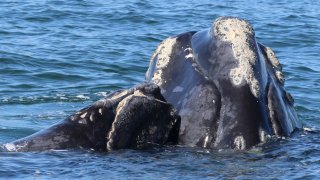
North Atlantic right whales gave birth over the winter in greater numbers than scientists have seen since 2015, an encouraging sign for researchers who became alarmed three years ago when the critically endangered species produced no known offspring at all.
Survey teams spotted 17 newborn right whale calves swimming with their mothers offshore between Florida and North Carolina from December through March. One of those calves soon died after being hit a boat, a reminder of the high death rate for right whales that experts fear is outpacing births.
The overall calf count equals the combined total for the previous three years. That includes the dismal 2018 calving season, when scientists saw zero right whale births for the first time in three decades. Still, researchers say greater numbers are needed in the coming years for North Atlantic right whales to rebound from an estimated population that's dwindled to about 360.
“What we are seeing is what we hope will be the beginning of an upward climb in calving that’s going to continue for the next few years,” said Clay George, a wildlife biologist who oversees right whale surveys for the Georgia Department of Natural Resources. “They need to be producing about two dozen calves per year for the population to stabilize and continue to grow again.”
We're making it easier for you to find stories that matter with our new newsletter — The 4Front. Sign up here and get news that is important for you to your inbox.
Right whales migrate each winter to the warmer Atlantic waters off the Southeastern U.S. to give birth. Trained spotters fly over the coastline almost daily during the calving season, scanning the water for mothers with newborns.
Survey flights over Georgia and Florida ended Wednesday on the last day of March, typically the season's end. Spotters will monitor waters off the Carolinas through April 15, hoping to pick up any overlooked newborns as the whales head north to their feeding grounds.
This season's calf count matches the 17 births recorded in 2015. Right whale experts consider that number fairly average, considering the record is 39 births confirmed in 2009.
U.S. & World
The day's top national and international news.
Scientists suspect a calving slump in recent years may have been caused by a shortage of zooplankton to feed right whales in the Gulf of Maine and the Bay of Fundy off Nova Scotia. They say the uptick in births this season could be a result of whales being healthier after shifting to waters with more abundant food sources.
“It's a somewhat hopeful sign that they are starting to adjust to this new regime where females are in good enough condition to give birth,” said Philip Hamilton, a right whale researched at the New England Aquarium in Boston.
Regardless, conservationists worry that right whales are dying — largely from manmade causes — at a faster rate than they can reproduce.
Since 2017, scientists have confirmed 34 right whale deaths in waters of the U.S. and Canada — with the leading causes being entanglement in fishing gear and collisions with boats and ships. Considering additional whales were documented in the same period with serious injuries they were unlikely to survive, researchers fear the real death toll could be at least 49.
That would exceed the 39 right whale births recorded since 2017.
“If we reduced or eliminated the human-caused death rate, their birth rate would be fine,” Hamilton said. "The onus should not be on them to reproduce at a rate that can sustain the rate at which we kill them. The onus should be in us to stop killing.”
The federal government is expected to finalize new rules soon aimed at decreasing the number of right whales tangled up in fishing gear used to catch lobster and crabs in the Northeast. Proposals to reduce vertical fishing lines in the water and modify seasonal restricted areas have been met with heated debate. Fishermen say the proposed rules could put them out of businesses, while conservation groups insist they aren't strict enough.
The National Marine Fisheries Service received more than 170,000 public comments on the proposed rules after a report was issued Dec. 31, said agency spokeswoman Allison Garrett. She said final rules should be published this summer.
Garrett said the fisheries service is also considering adjustments to federal rules that since 2008 have imposed speed limits on larger vessels in certain Atlantic waters during seasonal periods when right whales are frequently seen. An agency report in January found mariners' compliance with the speed ruleshave improved overall, but still lagged below 25% for large commercial vessels at four ports in the Southeast.
“We’ve long known from the survival estimates that more right whales are dying than those we see,” said George, the whale survey coordinator for Georgia. “They need to be producing a lot more calves. But the big issue is we’ve got to significantly reduce the number than are being entangled in fishing ropes and struck by boats."



